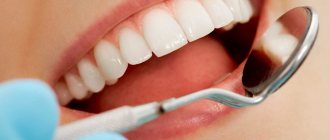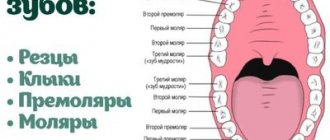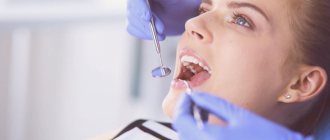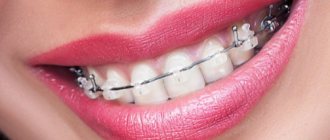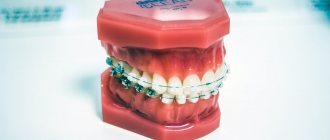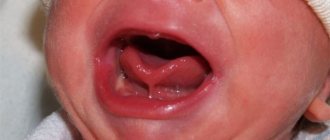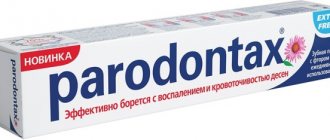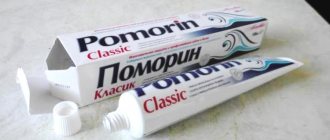Causes of displacement Correction Possible consequences Determination of occlusion Possible consequences Methods of correction
Displacement of teeth is a change in their position after the formation of the dentition has completed, as a result of illness or injury. When teeth erupt, they also change location. This is called primary movement. All other cases are secondary movements.
Teeth can change their position in different directions; most often the following types of movements occur:
- vertical (one-sided or two-sided);
- distal – the tooth goes back;
- mesial – the tooth moves forward;
- bends;
- rotation around an axis;
- combined.
Why is it necessary to replace extracted teeth?
When free space appears in the jawbone, bone tissue gradually begins to decrease, the alveolar ridge thins, and the teeth begin to move, trying to fill the vacant space. Due to the disappearance of lateral support, the “neighbors” of the removed tooth begin to move. The antagonist tooth located on the opposite jaw moves out and “sags”. Due to this, the patient’s bite is disturbed, and the resulting deformations cause new troubles. The more years pass from the moment of removal, the more significant the anomalies will become. Problems can even arise with the temporomandibular joint, which will cause serious pain and disruption of its functionality.
Let's look at a typical example. With a prolonged absence of the “six” and “seven” in the lower row, the last molar tooth of the upper jaw can “sag” so much that it literally rests against the lower gum. In this case, there is no longer any need to talk about conventional dental restoration
What is cheaper - braces or implants with crowns?
Both methods cost approximately the same price.
In our Center, the cost of implantation consists of 3 items:
- Surgical stage. Provides manipulations for the introduction of a titanium pin with the inclusion of the necessary materials and services of an implantologist in the price. Cost - 65-85 thousand rubles.
- Crown installation. When the implant takes root, a crown is installed on it. Its price ranges from 48 to 55 thousand rubles, depending on the production technology.
- Bone growth. If the bone tissue is thinning, it will require preliminary extension, which will cost from 24 thousand rubles.
Total: the cost of implanting one tooth is from 137 thousand rubles.
During orthodontic treatment to replace one dental unit, row correction involves installing braces on both jaws. Options and combinations of designs differ, which is why the price ranges from 62-127 thousand rubles per jaw (the most expensive are made from sapphire). When installing braces on both jaws, the price doubles.
Total: to install the cheapest braces on both jaws you will need 124 thousand rubles.
How can you solve the problem?
A layman will immediately name two obvious solutions:
- remove protruded tooth;
- file down its coronal part.
Removing a tooth without pain can only be justified by its severe destruction, and even accompanied by the patient’s complete reluctance to seriously engage in dental treatment.
Filing the crown does not seem rational either. After all, for this you will have to remove the nerve of the tooth, since it will have to be “shortened” by more than half, and then covered with an artificial crown. It is difficult to call the formed “formation” a full-fledged tooth. “Grinding” is not required only when the molar is slightly advanced, when you can limit yourself to grinding its cusps to the existing bite height.
The best option is orthodontic treatment, since it is the orthodontist who deals with problems of tooth displacement. Modern technologies make it possible to return a “failed” upper molar to its place.
Clinical situations
If orthodontic treatment is required
If a patient is missing one tooth and requires orthodontic correction of the dentition, it is better to opt for braces - this way the teeth will be in the correct position and at the same time the space will be closed. No surgical intervention is required, there are no contraindications and there is less risk to health.
But this option is suitable if one of the distant teeth is missing. If there is a lack of anterior or several dental units, implantation is indispensable. Before installing implants, braces are first put on. To maintain space for the titanium root, a spring is attached to the adjacent teeth, holding them at the desired distance. An artificial root can also be inserted during orthodontic treatment - during the period of wearing braces, the implant will take root.
If the dentition is straight
If the dentition is straight or has already been treated with braces, it is better to install an implant, since the teeth are already in the correct positions. This treatment will require surgery, but will be faster than wearing braces. If implantation is not possible for any reason, repeated orthodontic treatment is carried out.
Despite the patient’s wishes, the final decision on whether to pull out a tooth with braces or place an implant remains with the doctor.
Mini-implants - as a basis for orthodontic treatment
The procedure for installing mini-implants is carried out under local anesthesia and does not require any incisions or sutures. A puncture is simply made in the tissue through which the surgeon implants a titanium implant. But simple and low-traumatic manipulations should be performed by a highly qualified specialist who can take into account the peculiarities of the location of the dental roots so as not to injure the tooth.
- In this example, small orthodontic dental implants will be installed next to the lowered upper “seven” - one each on the vestibular (external) and lingual (internal) sides.
- The orthodontist will glue special hooks to the molar on both sides, which will be connected to the heads of the implants using elastics. This way, the doctor will create a constant force, supported by the implants, pulling the sagging tooth back into the jaw bone.
- As with treatment with braces, stretchable elastic bands will need to be replaced periodically, for which you will have to visit the clinic. At the same time, the orthodontist will monitor the process, correcting the movement of the problem tooth.
As a result, a place for prosthetics will be obtained without removing, depulping or grinding the molar.
Participation of a speech therapist in dental treatment
Considering the situation from all sides, the doctors paid attention to the position of the woman’s tongue. The fact is that normally, the pressure of the tongue from inside the mouth should be directed to a certain point on the palate. With the loss of teeth, their wear, malocclusion, and for a number of other reasons, the tongue begins to put pressure not on the palate, but on the teeth from the inside. The tongue is a powerful muscle that can develop pressure up to 500 g. This pressure is enough to force the teeth apart. Normally, the pressure of the tongue is partially or completely balanced by the muscles of the lips. Myodynamic balance occurs at rest and during function (eating, swallowing, speaking, etc.). With muscular balance, the teeth stand exactly for years and no deformations occur. If the deformity progresses, it means that the pressure of one muscle dominates, causing the teeth to shift. In this case it was language.
The Family Dental Clinic employs a neuromuscular therapist with a primary specialty of speech therapist, T. B. Tsukor. She knows everything about the work of the tongue, lips and facial muscles. It was she who was approached by an orthopedic doctor in order to solve the issue of tongue dysfunction and help the patient.
After analyzing the situation, the speech therapist came to the conclusion that the tongue is really to blame for the fact that the teeth are moving apart and the gaps between the teeth are increasing. The tongue pressed from the inside incorrectly - not on the front of the palate, but on the lower teeth. This situation with the incorrect position of the tongue had happened before and arose as a result of the patient’s difficult situation associated with the absence of many teeth and bite deformation. The bite was corrected, but the tongue muscles continued to work in a dysfunctional mode. The doctors were faced with the task of dealing with the dysfunction in order to stabilize the situation. An examination by our special and very rare speech therapist-neuromuscular therapist revealed weakness of the patient’s lower lip. This became an additional factor in aggravating the deformity, since the lip did not provide the necessary resistance.
Speech therapist's appointment:
The speech therapist, having conducted an examination and identified the causes of the incident, passed on the information to the treating prosthetist. The speech therapist offered the patient a set of exercises to normalize the position of the tongue and strengthen the lips. The complex included exercises for the lips, for the tongue, for developing a directed air stream, and for producing sounds. The patient performed this complex at home with periodic control conversations with a speech therapist via Skype. Skype checks made it possible for the patient not to come to the clinic and saved her time and effort. Classes with a speech therapist via Skype are a valuable opportunity that Dial-Dent provides to its clients. The patient performed the exercises exactly as prescribed. This is very important to achieve results. The teeth stopped moving apart, and the situation stabilized. But the initial result was already lost, and doctors had to decide how to return the lower teeth to their previous positions.
General overview
Features of the pathology of displacement of the midline of teeth have long been of interest not only to dentists, but also to patients. At the very least, it is important to familiarize yourself with the norms for passing the center in a person.
If we give an aesthetic assessment, then in the absence of an anomaly, a person should have symmetry of the dentition and the coincidence of the median line of the face with the interincisal midlines (but this is not a pattern).
If the median line is inclined, then this always causes a violation of symmetry. The pathology takes on a pronounced character if it is accompanied by a shift in the midline to one side of the smile, which in the normal state should be in the center and in harmony with the rows of teeth.
It is no secret that, first of all, others pay attention to a person’s face. Any violation in the proportions of the face and upper jaw row negatively affects the beauty of the smile.
It is possible to note the ideal proportionality and harmony of the face only if there are strictly vertical straight teeth.
If the considered proportions of the face and dentition do not coincide, during the correction process the center of the jaw row should be located perpendicular to the interpupillary line.
Important! The midline of the teeth always acts as a guide for orthopedic dentists in the process of drawing up an aesthetic correction plan.
How to correct a crooked upper jaw and which method is most effective.
Come here to find out which method is the most gentle for correcting a small lower jaw.
At this address https://orto-info.ru/zubocheliustnye-anomalii/chelyustey/rashirnie.html we will consider ways to expand the dentition.
Diagnostic measures
To identify the type of displacement, a photograph of a smile is assessed and the patient is prescribed an orthopantomogram. From the photo you can determine the presence of displacement and the degree of its severity. Using the second diagnostic method, the type of anomaly is determined.
If the clinic is not examined using OPTG, the problem will remain unrecognized and the patient will remain without treatment for the incorrect axial inclination of the frontal elements of the row.
The issue of correct diagnosis arises especially acutely in adult patients with increased abrasion of the cutting line of the upper jaw incisors and in children with teeth with traumatic chips.
The keys to optimally choosing treatment tactics are:
- length of the coronal part of the frontal units;
- posterior level of the occlusal plane;
- incisal platform;
- pupil lines.
If a discrepancy is detected between the line of the pupils and the incisal platform, the specialist performs a number of assessment actions:
- The relationship between the pupil line and the posterior and anterior levels of the occlusal surface is determined. If there is an obvious discrepancy, the cause of the displacement is most likely the pathological growth of the branches of the movable jaw.
- Determining the presence of a relationship between the posterior level of the occlusal plane and the pupil line. The coincidence indicates that the anomaly developed against the background of bad habits - thumb sucking, etc.
To thoroughly study the causes of the anomaly, the orthodontist must:
- Assess the morphometric parameters of the patient’s jaw apparatus and characterize his condition.
- Visually inspect the patient's jaw arches and assess the position of the units in relation to the midline of the face.
A tooth started to loosen: how to save it at home
If a tooth is loose, you can save it at home (as part of complex therapy). In the initial stages, massage of the gums and the area around the loose tooth helps. It is important to perform it systematically (twice a day for 3–4 minutes). Problem areas are massaged in a circular motion without causing excessive stress. After each massage session, it is necessary to rinse your mouth with a decoction of medicinal herbs (for example, chamomile or sea buckthorn).
Also, at home you need to use gels that relieve inflammation and improve blood circulation in tissues (as prescribed by a doctor) and adjust your usual diet (add foods rich in vitamins and minerals).
Symptoms of diastema
The gap between the teeth can have different severity. The gap is rarely narrow and parallel; more often the central incisors have a deviation, so the gap is characterized by a triangular shape. The apex of such a triangle can be facing both the gums and the cutting edge of the teeth. The diastema is often accompanied by a powerful frenulum of the upper lip, part of which is attached to the crest of the alveolar process and the incisive papilla. The defect is accompanied by other anomalies. The most common of them are the following:
- Trema - lack of close contact between the teeth, gaps not only between the front incisors, but also the chewing teeth;
- microdentia - small teeth;
- malocclusion;
- rotation of the cutters along the axis.
This exacerbates the aesthetic problem. A person may experience embarrassment and discomfort when talking, smiling, and avoid new acquaintances and communication.
Diastema increases the risk of developing periodontal disease in the area of the front teeth. This is due to improper distribution of the chewing load, unstable position of the teeth - lack of lateral supports. Periodontal disease can cause healthy teeth to become loose and there is a high risk of losing them.
Very often the anomaly is accompanied by speech disorders. This is usually expressed in the inability to pronounce certain sounds, a lisp, and a characteristic whistling.
